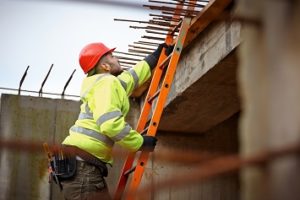March is National Ladder Safety Month, an observance organized by the American Ladder Institute (ALI) to raise awareness about ladder hazards and provide resources to prevent ladder-related injuries. Yesterday, we covered some key safe work practices for employees who use ladders. Today, we’ll review the basics of OSHA’s compliance requirements for ladders.
OSHA covers ladder use in a variety of standards, including in the stairways and ladders subpart of the agency’s construction standards and in the general industry standards for walking and working surfaces.
The following are among rules that apply to all ladders:
- Maintain ladders free of oil, grease, and other slip hazards.
- Do not load ladders beyond their maximum intended load or beyond the manufacturer’s rated capacity.
- Do not user ladders on slippery surfaces unless they are secured or provided with slip-resistant feet.
- Take steps to secure ladders in areas where they can be displaced by work activities.
- Keep areas clear around the top and bottom of ladders.
- Do not move, shift, or extend ladders while in use.
- Use ladders equipped with nonconductive side rails if the worker or the ladder could contact exposed, energized electrical equipment.
- Face the ladder when moving up or down.
- Use at least one hand to grasp the ladder when climbing.
- Do not carry objects or loads that could cause loss of balance and falling.
Other OSHA requirements address specific ladder types:
- Do not use single-rail ladders.
- Use wooden ladders built at the jobsite with spliced side rails at an angle where the horizontal distance is one-eighth the working length of the ladder.
- The top of a non-self-supporting ladder must be placed with two rails supported equally unless it is equipped with a single-support attachment.
- Do not use the top step of a stepladder as a step.
- Do not use cross bracing on the rear section of stepladders for climbing unless the ladders are designed and provided with steps for climbing on both front and rear sections.
- Metal spreader or loading devices must be provided on stepladders to hold the front and back sections in an open position when ladders are being used.
- If the total length of the climb on a fixed ladder equals or exceeds 24 feet (ft), the ladder must be equipped with ladder safety devices or self-retracting lifelines and rest platforms at specified intervals.
OSHA also has specific rules around defective ladders.
- Portable ladders with structural defects like broken or missing rungs, broken rails, or other defects must immediately be marked defective or tagged “do not use” and withdrawn from service until they are repaired.
- Fixed ladders with structural defects must be withdrawn from service until repaired.
- Defective fixed ladders are considered withdrawn from use when they are immediately tagged “do not use” or marked in a way that identifies them as defective.
- Repairs must restore the ladder to a condition meeting its original design criteria before the ladder is returned to use.

